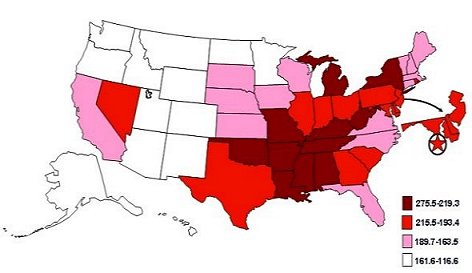 |
|
 |
 |
 |
Women and Heart Disease Fact Sheet
This document is also available in
Portable
Document Format (PDF–94K).
 Learn more about
PDFs. Learn more about
PDFs.
Death Rates for Diseases of the Heart per 100,000
Women, 2002

[A
text version of this
graphic is also available.]
Age-adjusted to the 2000 U.S. Population; International Classification of Diseases (ICD–10) codes: I00–I09, I11,
I13, I20–I51.
Data Source: National Center for Health Statistics (NCHS)
Facts on Women and Heart Disease
- For this fact sheet, the term "heart disease" refers to the broadest category of "diseases of the heart" as defined by the International Classification of Diseases and used by CDC's National Center for Health Statistics. This category includes acute rheumatic fever, chronic rheumatic heart disease, hypertensive heart disease, coronary heart disease, pulmonary heart disease, congestive heart failure, and any other heart condition or disease.
- Although heart disease is sometimes thought of as a "man's disease," it is the leading cause of death for both women and men in the United States
and women account for 51% of the total heart disease deaths.
- Of the 1,244,123 deaths among women in 2002, 28.6% were due to diseases of the heart.
- Awareness of heart disease as the number one killer of women:
- Good news: According to surveys by the American Heart Association, the percentage of women who spontaneously identified heart disease as the number one killer of women increased from 30% in 1997 to 46% in 2003.
- Bad news: Only 13% of the women in the 2003 survey perceived heart disease as their greatest health problem. While this is an increase from the 7% level in 1997, it still reflects an attitude that heart disease is
"not my problem."
- Heart disease is often perceived as an "older woman's disease," and it is the leading cause of death among women aged 65 years and older. However, heart disease is the 3rd leading cause of death among women aged 25–44 years and the 2nd leading cause of death among women aged 45–64 years.
- In 2002, age-adjusted death rates for heart disease were higher among black women (169.7 per 100,000) than among white women (131.2 per 100,000).
There is a range of risk for heart disease depending on family and personal health history and the treatment recommendations from a physician will depend on a woman's level of risk. Regardless of the risk level, these lifestyle modifications are recommended for all women:
- Cigarette smoking cessation
- 30 minutes physical activity most days
- Heart-healthy diet
- Weight maintenance/reduction
- Evaluation and treatment of depression
CDC Activities to Reduce the Burden of Heart Disease Among Women
- CDC co-sponsored two international conferences on women and heart
disease and stroke in 2000 and 2005. The Victoria Declaration on
Women, Heart Disease, and Stroke, 2000, resulted from the first
conference and is available on
Canada's Heart Health
Initiative Web site.*
- CDC supports National Wear Red for Women day, which is conducted to
raise awareness of the importance of heart health among women.
- CDC participates in the development of guidelines for cardiovascular
disease prevention in women. The most recent guidelines were published
in the journal Circulation 2004;109:672–673.
- On-going surveillance of heart disease and its risk factors by gender.
Maps of Heart Disease and Stroke Mortality Among Women and Men
The interactive maps
present heart disease and stroke mortality rates, county-by-county, for
the state, racial/ethnic group, and gender of your choice. These maps
provide valuable information for health professionals and concerned
citizens at the local, state, and national levels to identify the
communities of women and men with the greatest burden of heart disease and
to design heart disease prevention programs and policies tailored to the
needs of those communities. These maps were developed through a
collaboration between CDC and researchers at West Virginia University and
the University of South Florida, and are part of three documents entitled The
Atlas of Stroke Mortality: Racial, Ethnic, and Geographic Disparities
in the United States;
Women and Heart
Disease: An Atlas of Racial and Ethnic Disparities in Mortality; and
Men and Heart Disease: An Atlas of Racial and Ethnic Disparities in
Mortality.
http://www.cdc.gov/DHDSP/library/maps/statemaps.htm.
For More Information
For more information on women and heart disease, visit the following Web sites:
- CDC's Cardiovascular Health Program
- A Public Health
Action Plan to Prevent Heart Disease and Stroke
A Public Health Action Plan to Prevent Heart Disease and Stroke is a
groundbreaking collaboration that will help to guide the nation's heart
disease and stroke prevention efforts over the next decades. The
Action Plan was developed by public and private partners who are
committed to preventing disease rather than treating its consequences
and to transforming public health agencies and their partners into
effective agents of change. A national forum of experts, representing
some 50 national and international organizations, serves as the vehicle
for implementing the Action Plan. The three lead partners are the
American Heart Association/American Stroke Association, the Association
of State and Territorial Health Officials, and CDC, which provides core
support for convening the national forum and implementing the Action
Plan.
- American Heart Associatio
(AHA)
*
- Go Red for Women campaign
- AHA Guidelines: Evidence-Based Guidelines for Cardiovascular Disease Prevention in Women
- Association of Black Cardiologists
*
- The African American Woman's Guide to a Healthy Heart
- Heart Health for the Generations: A Guide for African-American Women featuring Maya Angelou
- National Heart, Lung, and Blood Institute
*Links to non–Federal organizations are provided solely as a service to our users. Links do not constitute an endorsement of any organization by CDC or the Federal Government, and none should be inferred. The CDC is not responsible for the content of the individual organization Web pages found at this link.
Back to Top
Date last reviewed:
10/05/2006
Content source: Division for Heart Disease and Stroke
Prevention,
National Center for Chronic Disease Prevention and
Health Promotion |
 |